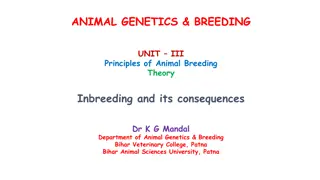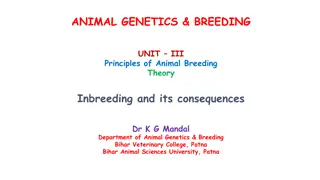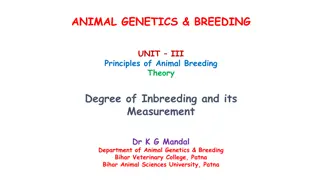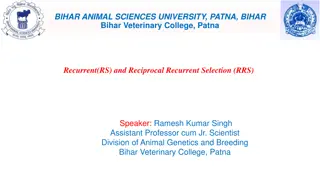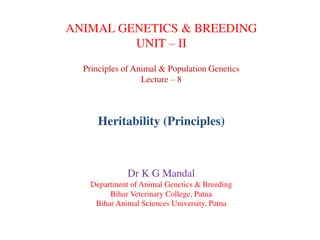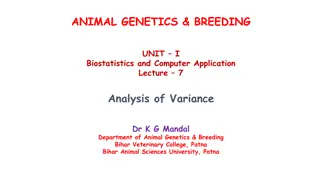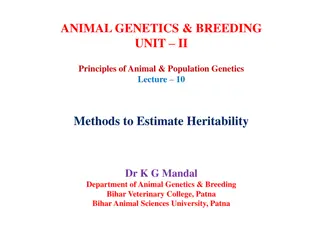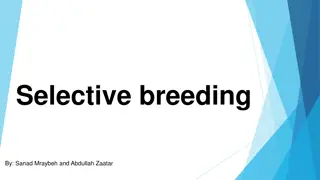Principles of Animal Genetics and Breeding in Farm Animals
Explore the fundamentals of animal genetics and breeding with a focus on inheritance, variation, and genetic improvement in farm animals. Learn how genetics principles, population genetics, and molecular genetics play a vital role in enhancing livestock production. Discover the economic traits in cattle and buffalo, along with the growth of the Indian dairy sector.
Download Presentation

Please find below an Image/Link to download the presentation.
The content on the website is provided AS IS for your information and personal use only. It may not be sold, licensed, or shared on other websites without obtaining consent from the author. Download presentation by click this link. If you encounter any issues during the download, it is possible that the publisher has removed the file from their server.
E N D
Presentation Transcript
ANIMAL GENETICS & BREEDING Theory Introduction Dr K G Mandal Univ. Professor Department of Animal Genetics & Breeding Bihar Veterinary College, Patna Bihar Animal Sciences University, Patna
Introduction to Animal Genetics & Breeding PAPER UNIT Broad Headings Paper I UNIT - 1 1. Biostatistics 2. Computer Application UNIT 2 1. Principles of Animal Genetics 2. Principles of Population Genetics Paper - II UNIT 3 1. Principles of Animal Breeding (a) Livestock & Poultry Breeding (b) Breeding of pet, zoo and wild animas
What is genetics? How the characters are inherited from parents to progeny? How the offspring parents? How a man produce a child and how a cow produce only a calf not lamb or kid? Why there is variation from individual to individual, among offspring of the same parents? resemble the
How the principles of genetics and population genetics can be applied for genetic improvement of farm animals and birds? How molecular genetics can be applied for genetic improvement of farm animals? What is statistics? How the various statistical methods can be applied to solve the problems of animal breeding?
Glorious Journey of Indian Dairy Sector India the largest milk producing country in the world. It produces 21% of world milk production. The overall growth rate of milk production is 6.5% for the year 2018 19. Total milk produced in 2018 19 is 187m tons. By 2033 34, country s milk production will be 330 m tones (NITI Ayog).
Year Milk Production (million tons) Per capita availability (g ) 1950 - 51 17.0 1970 71 22.0 1990 91 2000 - 01 53.9 80.69 2011 - 12 128.4 2012 13 2015 - 16 134.0 155.4 307 2018 19 187.7 394
Types of characters/traits: 1. Qualitative traits 2. Quantitative traits (a).Biometric traits (b). Econometric traits (c). Polygenic traits
Economic traits: 1. Cattle and buffalo i) milk production ii) fat % iii) LMY (Lactation Milk Yield) iv) ADMY (Average daily milk yield) v) ASM (Age at sexual maturity) vi) CI (calving interval) vii) Dry period, viii) Service period ix) Life time production, etc.
A crossbred cow should produce one calf in 13 to 14 months interval to make the dairy enterprise profitable. An indigenous dairy cow should produce one calf in every 14 to 15 months interval. A buffalo cow should produce one calf in every 15 16 months interval. All the economic traits should be improved, but how?
2. Sheep How to improve the quality and quantity? How to increase the lambing size? - Fine wool production - Medium wool production - Long wool production - Fine carpet wool production - Good quality mutton production - To increase lambing size
3. Goat 4. Poultry - Milk and meat (chievon) - Only for meat - Skin and hides - Pashmina and mohair - kidding size - Layer for egg production - Broiler for meat production - Moderate no. of eggs and meat prodn
Objective: 1. To study the Principles of Genetics and Animal Genetics in particular. 2. To study the Principles of Population Genetics and Quantitative Genetics. 3. To study the Principles of Selection. 4. To study the Principles of Animal Breeding and Poultry Breeding. 5. To study the Biostatistics and computer application for better understanding of the subject. 6. To increase the genetic potentiality of livestock and birds species. Continued
Continued .. Genetic improvement of livestock and birds species through the application of principles of genetics, and population genetics in particular, along with biometric techniques is the ultimate objective of the study of Animal Genetics and Breeding.
Books Referred: Sl. No. Title of books Authors Publication A. Biostatistics 1. Statistical Methods Dr S P Gupta Sultan Chand & Sons 2. Statistical Methods Snedecor & Cochran Oxford & IBH Pub. Co. 3. Biostatistics P. N. Arora & PK Malhan Himalaya Pub. House 4. Statistical Methods for Biological Workers SK Pillai & HC Sinha Ram Prasad & Sons, Agra B. Genetics 1. Principles of Genetics Sinnott, Dunn & Dodzhansky TMH Pub. Co. Ltd. 2. Principles of Genetics Gardner & Snustad 3. Genetics Strickberger Macmillan
Sl. No. Title of books Authors Publication C. Population Genetics 1. Introduction to quantitative Genetics DS Falconer Longman, London 2. Population Genetics (I & II) SS Tomar I.Universal Publica. II. Kalyani Pub. D. Animal Breeding 1. Anima Breeding Warwicks & Legates 2. Animal Breeding SS Tomar Kalyani Publishers 3 Hand Book of Animal Husbandry ICAR, Newdelhi ICAR, Newdelhi E. Basic Computer Science Any author



